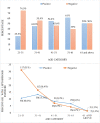Sero-prevalence of anti-Leptospira antibodies and associated risk factors in rural Rwanda: A cross-sectional study
- PMID: 34874936
- PMCID: PMC8683035
- DOI: 10.1371/journal.pntd.0009708
Sero-prevalence of anti-Leptospira antibodies and associated risk factors in rural Rwanda: A cross-sectional study
Abstract
Background: Leptospirosis is a zoonotic disease transmitted through the urine of wild and domestic animals, and is responsible for over 50,000 deaths each year. In East Africa, prevalence varies greatly, from as low as 7% in Kenya to 37% in Somalia. Transmission epidemiology also varies around the world, with research in Nicaragua showing that rodents are the most clinically important, while studies in Egypt and Chile suggest that dogs may play a more important role. There are no published studies of leptospirosis in Rwanda.
Methods & findings: We performed a cross-sectional survey of asymptomatic adults recruited from five occupational categories. Serum samples were tested using ELISA and Microscopic Agglutination Test (MAT). We found that 40.1% (151/377) of asymptomatic adults had been exposed to Leptospira spp. Almost 36.3% of positive subjects reported contact with rats (137/377) which represent 90.7% among positive leptospira serology compared with 48.2% of negative subjects (182/377) which represent 80.5% among negative leptospira serology (OR 2.37, CI 1.25-4.49) and 1.7 fold on prevalence ratio and 2.37 of odd ratio. Furthermore, being a crop farmer was significantly associated with leptospirosis (OR 2.06, CI 1.29-3.28). We identified 6 asymptomatic subjects (1.6%) who met criteria for acute infection.
Conclusions: This study demonstrates a high prevalence of leptospiral antibodies infection among asymptomatic adults in rural Rwanda, particularly relative to neighboring countries. Although positive subjects were more likely to report rat contact, we found no independent association between rats and leptospirosis infection. Nonetheless, exposure was high among crop farmers, which is supportive of the hypothesis that rats together with domestic livestock might contribute to the transmission. Further studies are needed to understand infecting Leptospira servers and elucidate the transmission epidemiology in Rwanda and identify means of host transmitters.
Conflict of interest statement
The authors have declared that no competing interests exist.
Figures



Similar articles
-
Leptospirosis in sugarcane plantation and fishing communities in Kagera northwestern Tanzania.PLoS Negl Trop Dis. 2019 May 31;13(5):e0007225. doi: 10.1371/journal.pntd.0007225. eCollection 2019 May. PLoS Negl Trop Dis. 2019. PMID: 31150391 Free PMC article.
-
Leptospira seroprevalence and associated risk factors among slaughterhouse workers in Western Bahr El Ghazal State, South Sudan.PLoS Negl Trop Dis. 2024 Dec 11;18(12):e0012700. doi: 10.1371/journal.pntd.0012700. eCollection 2024 Dec. PLoS Negl Trop Dis. 2024. PMID: 39661611 Free PMC article.
-
Sero-prevalence of leptospirosis and differentiation in blood parameters between positive and negative cases in dogs of Kathmandu Valley.Trans R Soc Trop Med Hyg. 2018 Aug 1;112(8):378-382. doi: 10.1093/trstmh/try065. Trans R Soc Trop Med Hyg. 2018. PMID: 30010976
-
Epidemiology of leptospirosis in Tanzania: A review of the current status, serogroup diversity and reservoirs.PLoS Negl Trop Dis. 2021 Nov 16;15(11):e0009918. doi: 10.1371/journal.pntd.0009918. eCollection 2021 Nov. PLoS Negl Trop Dis. 2021. PMID: 34784354 Free PMC article.
-
Epidemiology of human and animal leptospirosis in Kenya: A systematic review and meta-analysis of disease occurrence, serogroup diversity and risk factors.PLoS Negl Trop Dis. 2024 Sep 27;18(9):e0012527. doi: 10.1371/journal.pntd.0012527. eCollection 2024 Sep. PLoS Negl Trop Dis. 2024. PMID: 39331677 Free PMC article.
Cited by
-
Leptospirosis in humans and selected animals in Sub-Saharan Africa, 2014-2022: a systematic review and meta-analysis.BMC Infect Dis. 2023 Oct 3;23(1):649. doi: 10.1186/s12879-023-08574-5. BMC Infect Dis. 2023. PMID: 37784071 Free PMC article.
-
Global distribution of Leptospira serovar isolations and detections from animal host species: A systematic review and online database.Trop Med Int Health. 2024 Mar;29(3):161-172. doi: 10.1111/tmi.13965. Epub 2024 Feb 13. Trop Med Int Health. 2024. PMID: 38351504 Free PMC article.
-
Global distribution of Leptospira serovar isolations and detections from animal host species: a systematic review and online database.medRxiv [Preprint]. 2023 Oct 3:2023.10.03.23296503. doi: 10.1101/2023.10.03.23296503. medRxiv. 2023. Update in: Trop Med Int Health. 2024 Mar;29(3):161-172. doi: 10.1111/tmi.13965. PMID: 37873107 Free PMC article. Updated. Preprint.
-
Leptospirosis seroprevalence and risk factors among slaughterhouse workers in Burkina Faso.IJID Reg. 2023 Oct 30;9:125-130. doi: 10.1016/j.ijregi.2023.10.008. eCollection 2023 Dec. IJID Reg. 2023. PMID: 38074946 Free PMC article.
-
Knowledge, attitudes, practices (KAP), and risk factors toward zoonotic diseases among smallholder livestock farmers in Bugesera district of Rwanda.Front Public Health. 2025 Apr 17;13:1569682. doi: 10.3389/fpubh.2025.1569682. eCollection 2025. Front Public Health. 2025. PMID: 40313502 Free PMC article.
References
-
- Terpstra WJ, Adler B, Ananyina J, Ansdell V, Ashford A, Bakoss P et al. World Health Organization. Human leptospirosis: guidance for diagnosis, surveillance and control. 2003. http://www.who.int/iris/handle/10665/42667
-
- Ningal SP, Kothule MB, Jadhav NY, Kadam SD, Katare YS, Hapse SA et al.. A review on leptospirosis. Epidemiology. 2015; 3: 5–8.
MeSH terms
Substances
Grants and funding
LinkOut - more resources
Full Text Sources
Miscellaneous

